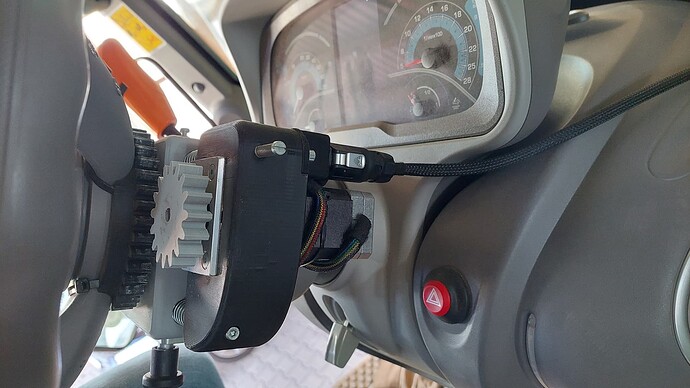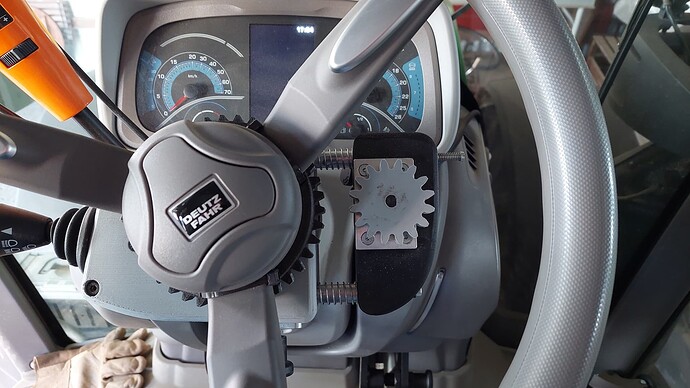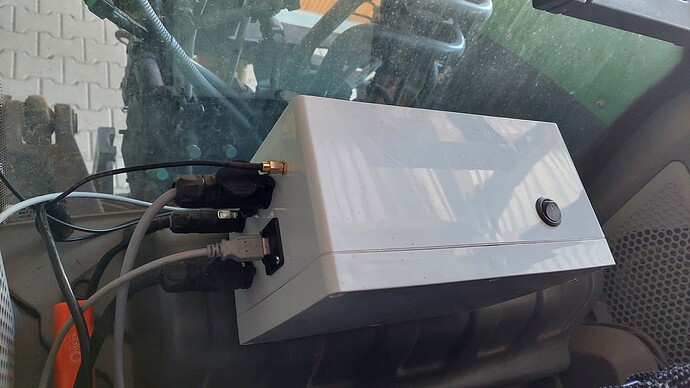Hi,
My name is Mathias and I am from Rheinland-Pfalz in Germany. I wanted to show you my Autosteer that I built in 2021.
Before I started with it I looked at different superstructures in the forums. But I found out that many people build their autosteer with “normal” DC motors including planetary gears. These were simply much too big for me and would have disturbed in the cabin.
Therefore I looked for alternatives. It was clear to me from the beginning that it will be a brushless motor because it is far superior in size and power to the normal DC motor with brushes.
I decided to use a Nema 23 motor from ACT-Motors.
So that the motor did not have to become unnecessarily large, there was no way around a planetary gear. Unfortunately the motor was not available with a gearbox. And the gearboxes I found were just too expensive. So I ordered a cheap Nema 23 stepper motor/planetary gear combination on Ebay. I calculated the right gear ratio in advance after I measured the needed steering forces.
Only when the stepper motor with gearbox was delivered, I could see if the shaft diameters of the motors are the same and the gearbox fits on the brushless motor. But I was lucky, they were both 6mm shafts. So I was able to pull the gear off the stepper motor, shorten the shaft of the brushless motor and glue it on the gear from the stepper motor. Now my brushless/planetary gear combination was ready.
Additionally I have to mention that the gearbox is not designed for the speed of the brushless motor. At least this is what I interpreted from the sparse data sheets. The gearbox has only plastic gears, but that doesn’t mean it shouldn’t last. The motor never runs at full speed anyway. But later I saw that the gearbox is also available in a slightly stronger version.
As a driver I use the original from ACT Motors. Was there in the set with the brushless motor. It is a bit oversized but that did not bother me ![]()
The autosteer is installed on a Deutz-Fahr Agrotron series 6. I use the original steering angle sensor of the Agrotron.
The goal was that the engine and the gear on the steering wheel would not obstruct the view of the instruments and the engine would be easy to decouple for road travel. A clutch would have been nice, but again would have taken up more space and wasn’t that cheap. I also didn’t want to invest vast sums in the project. That’s why I finally decided on a sliding design with detent pins.
Since I often turn the headland itself, the constant decoupling of the engine bothered me. This could be turned also in such a way but the effort was already somewhat increased. Therefore I installed a relay which disconnects the motor driver from the power supply. After that the motor could be turned very easily.
The only weak point of my construction was the 3D printed motor pinion, which wears out after longer use or accidentally driving into the stop at the connection to the gear shaft. Since the motor has about 50 watts, this is no wonder. I changed this by installing a small metal gear in the motor pinion.
So far I drive with an antenna (Ublox F9P) and a base station which is more than 200km away. With this I get quite good results. But I will dedicate myself when there is more time to make the system even better and more stable.



